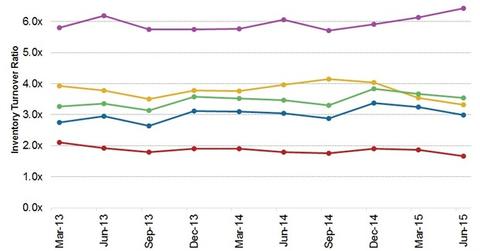How Coty Is Improving Its Distribution Channels
Coty sells its products through a multichannel distribution strategy across several price points in prestige and mass market channels of distribution.
Oct. 23 2015, Updated 11:06 a.m. ET

Multisegment manufacturing
Coty’s (COTY) brands are sold across several distribution channels, including the prestige and mass market channels in over 130 countries and territories.
The company manufactures 70% of its products in eight facilities located in the US, Europe, and China. Several of these locations provide multisegment manufacturing. Approximately 30% of Coty’s finished goods are manufactured according to third-party specifications.
Inventory turnover
The raw materials used to manufacture Coty’s products are essential oils, alcohol, and specialty chemicals. The inventory turnover ratio for Coty for 4Q15[1. Quarter ended June 30, 2015] was stable at ~3.0x compared to 4Q14.
Peers Estée Lauder (EL), Avon (AVP), and Procter & Gamble (PG) had inventory turnover ratios of 1.7x, 3.5x, and 6.4x, respectively, for 4Q15. The metric was lower for Coty due to lower consolidated sales that were affected by the adverse impact of foreign currency fluctuations.
Multichannel distribution
Coty sells its products through a multichannel distribution strategy across several price points in prestige and mass market channels of distribution. The company sells its products through a variety of retailers:
- hypermarkets
- supermarkets
- independent and chain drug stores
- upscale perfumeries
- upscale and mid-tier department stores
- specialty retailers
- duty-free shops
The company also sells through travel retail (XRT) channels, including airlines, cruise lines, and other tax-free and duty-free zones. Travel retail sales represented ~7% of the total net revenue in fiscal 2014.
Growing need to diversify
Coty plans to focus on its strategy of geographic expansion by selling through retailers, subsidiaries, or third-party distributors. In addition, the company aims to increase its e-commerce presence by selling through websites that support an e-commerce–only product distribution business. For example, Coty sells its philosophy product through a philosophy-branded website and through direct marketing on television.
Manufacturing network
Coty is streamlining manufacturing facilities to reduce costs and increase efficiencies. To complement its manufacturing network, the company plans to strengthen its third-party relations on a global basis to capitalize on supply chain benefits.
